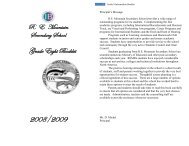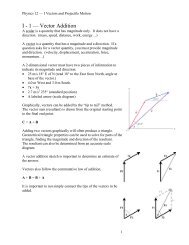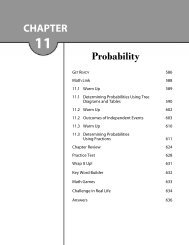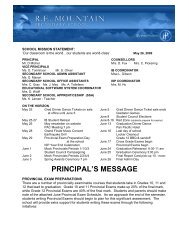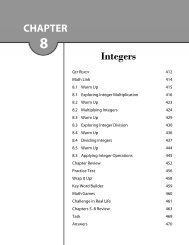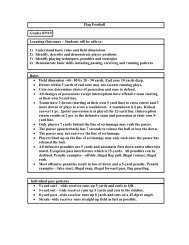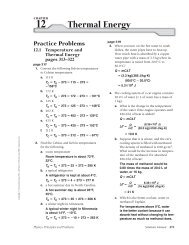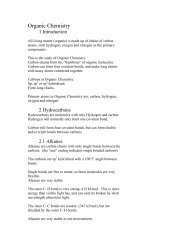Physics Solutions Manual
Physics Solutions Manual
Physics Solutions Manual
Create successful ePaper yourself
Turn your PDF publications into a flip-book with our unique Google optimized e-Paper software.
Chapter 24 continued<br />
87. A force of 5.7810 16 N acts on an<br />
unknown particle traveling at a 90° angle<br />
through a magnetic field. If the velocity of<br />
the particle is 5.6510 4 m/s and the field is<br />
3.2010 2 T, how many elementary<br />
charges does the particle carry?<br />
F qvB<br />
F<br />
q <br />
Bv<br />
3.2010 19 C<br />
N (3.201019 1charge<br />
C) 1.601019 C<br />
2 charges<br />
Mixed Review<br />
pages 667–668<br />
Level 2<br />
88. A copper wire of insignificant resistance<br />
is placed in the center of an air gap<br />
between two magnetic poles, as shown<br />
in Figure 24-34. The field is confined<br />
to the gap and has a strength of 1.9 T.<br />
7.5 cm<br />
■ Figure 24-34<br />
a. Determine the force on the wire (direction<br />
and magnitude) when the switch is<br />
open.<br />
0 N. With no current, there is no magnetic<br />
field produced by the wire and<br />
copper is not a magnetic material.<br />
b. Determine the force on the wire (direction<br />
and magnitude) when the switch is<br />
closed.<br />
Up, 0.62 N. The direction of the force<br />
is given by the third right-hand rule.<br />
I <br />
V<br />
R<br />
F ILB <br />
5.7810 16 N<br />
<br />
(3.2010 2 T)(5.6510 4 m/s)<br />
N S<br />
VLB<br />
R<br />
5.5 Ω<br />
24 V<br />
<br />
0.62 N<br />
c. Determine the force on the wire (direction<br />
and magnitude) when the switch is<br />
closed and the battery is reversed.<br />
Down, 0.62 N. The direction of the<br />
force is given by the third right-hand<br />
rule and the magnitude of the force<br />
is the same as in part b.<br />
d. Determine the force on the wire (direction<br />
and magnitude) when the switch is<br />
closed and the wire is replaced with a different<br />
piece having a resistance of 5.5 .<br />
Up, 0.31 N. The direction of the force<br />
is given by the third right-hand rule.<br />
I <br />
F ILB <br />
<br />
(24 V)(0.075 m)(1.9 T)<br />
<br />
5.5 <br />
V<br />
R<br />
(24 V)(0.075 m)(1.9 T)<br />
<br />
5.5 5.5 <br />
0.31 N<br />
89. Two galvanometers are available. One has<br />
50.0-A full-scale sensitivity and the other<br />
has 500.0-A full-scale sensitivity. Both<br />
have the same coil resistance of 855 . Your<br />
challenge is to convert them to measure a<br />
current of 100.0 mA, full-scale.<br />
a. Determine the shunt resistor for the<br />
50.0-A meter.<br />
Find the voltage across the meter<br />
coil at full scale.<br />
V IR (50.0 A)(855 ) 0.0428 V<br />
Calculate the shunt resistor.<br />
V<br />
R <br />
I<br />
0.428 <br />
VLB<br />
R<br />
0.0428 V<br />
<br />
100.0 mA 50.0 A<br />
b. Determine the shunt resistor for the<br />
500.0-A meter.<br />
Find the voltage across the meter<br />
coil at full scale.<br />
V IR (500.0 A)(855 ) 0.428 V<br />
496 <strong>Solutions</strong> <strong>Manual</strong> <strong>Physics</strong>: Principles and Problems<br />
Copyright © Glencoe/McGraw-Hill, a division of The McGraw-Hill Companies, Inc.





